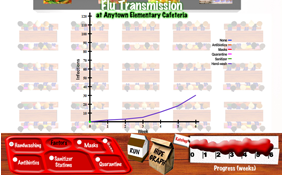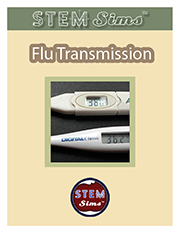This simulation is now free to raise awareness of steps to reduce the spread of COVID-19.
Flu Transmission
-
ChallengeBackgroundMethodsSimulationAssessment
 The aches, the fever, the nausea. It’s the flu and it makes you feel like you’ve been run over by a truck. If you have the flu, your illness is often due to one or more of your classmates infecting you with the influenza virus. What actions do you think a school can take to reduce the spread of the flu through the student population? You better get started though, the viruses can multiply by the millions within seconds.
The aches, the fever, the nausea. It’s the flu and it makes you feel like you’ve been run over by a truck. If you have the flu, your illness is often due to one or more of your classmates infecting you with the influenza virus. What actions do you think a school can take to reduce the spread of the flu through the student population? You better get started though, the viruses can multiply by the millions within seconds.
Here are some definitions to help you in your investigation.
Genes - the material inside cells that results in various traits
Virus - a small collection of material that make up genes that can infect and damage cells
Influenza - a virus that attacks the lungs, throat, and nose
Contagious - a disease that can easily spread among people
Epidemic - a disease that is widespread
Pandemic - a disease that has spread worldwide
Linear growth - growing by the same amount each time
Exponential growth - growing by doubling each time
Antibiotic - a drug that slows down the spread of infections due to bacteria
Bacteria - small, single-celled organisms that can spread disease while others can help other organismsReading and Interpreting a Line Graph
What is a Line Graph?
A line graph is a tool that provides a picture using a line or lines to show how things change over time or how they're connected. For instance, you want to see how a plant grows over time. So you measure the plant's height every week. You can use a line graph to see how the plant is growing!
Reading and Interpreting the Graph (See Figure 1.)
• Seeing Changes: Look at the line. If it goes up, the plant is growing! If it stays flat, it's not changing its height, and if the line goes down, the plant is losing height.
• Comparing Weeks: You can easily see which weeks the plant grew the most by looking for the steepest parts of the line.
Finding the Height (See Figure 2.)
• To find the plant height at a certain week, find that Week Number on the bottom line (x-axis), go straight up to the line, and then look across to the Plant Height number on the side (y-axis). On this graph, the plant at week 6 had a height of 9 centimeters.
Extrapolating the Data Beyond the Line (See Figure 3.)
• Following the Trend: If the line is going up or down steadily, you can predict that the plant will continue changing its height at about the same rate in the next few weeks.
• Making a Prediction: You can extend the line a little bit past your last data point (see the dashed line) to make a prediction about the plant's height in the future. But remember, it's just a prediction! Things might change.
Using our extended line in this graph, we predict the plant will have a height of 7 centimeters at week 11.
• Limitations: Extrapolating too far out is not always accurate. The plant could stop growing, or grow at a different rate.)
What is the flu?
The flu is a respiratory illness that is caused by the influenza virus and infects the nose, throat and lungs. It is contagious from one day before displaying symptoms to five to seven days after getting sick, and for younger children, is contagious for a longer time. The severity of the flu varies from one season to the next. It usually causes mild to severe illness, and occasionally even death.How does the flu infect your body?
The flu is mostly spread by tiny droplets that are made by people who have the flu when they sneeze, cough or talk. If these droplets are inhaled by or land in the mouths or noses of healthy people, it can infect those people with the flu too. A person can also be infected with the flu by touching a surface that has flu viruses on it, such as a doorknob or desk, and then touching their nose, eyes or mouth.What are the symptoms of the flu?
People that are infected with the flu often have headaches, a sore throat, a cough, a runny or stuffy nose, and muscle aches. Some people may have a fever as well as vomiting and diarrhea, though it is more common for children to have vomiting and diarrhea than adults. Also, only some people who contract the flu will have a fever.How can the flu be treated?
The flu can be treated with antiviral drugs, which fight the influenza virus in your body. Antiviral drugs can reduce the severity of flu symptoms and shorten the time that you are sick by 1-2 days. Antiviral drugs can also prevent serious complications from the flu like pneumonia. People that have other medical conditions like diabetes, asthma or heart disease are at an extra risk for flu complications, and these antiviral medicines can help reduce their risk of complications. These medicines work best when they are started within two days of developing symptoms, and should usually be taken for five days. Side effects of antiviral drugs are rare, but can include dizziness, nausea, vomiting, and headaches.What are some methods of preventing flu transmission?
The best way to avoid catching the flu is to get a flu vaccine. This can take two forms: a flu shot or a nasal-spray vaccine. People who have the flu should stay home from school, and can help prevent spreading it by washing their hands after they cough or sneeze, and by covering their nose and mouth when they cough and sneeze. You should cough into your elbow instead of your hands so that you don't get the germs on your hands. Common surfaces, such as doorknobs and desks, can be cleaned to remove any influenza viruses. People who are not sick should wash their hands often, and make sure to drink plenty of fluids and get plenty of rest.Walkthrough
Please wait while your video loads...Advanced Placement Lessons
Grade 6 - 12+ Lessons


